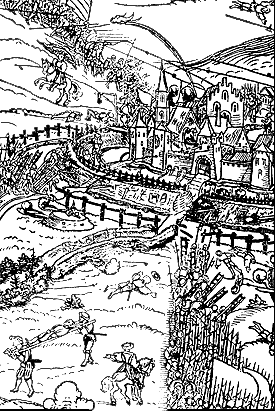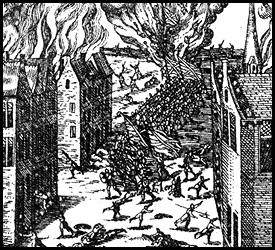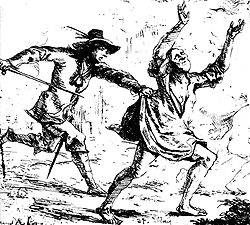 |
Final Assault |


As soon as a breach had been made, attackers had to storm soon (although there was one final assault made a full three days after the breach was made). Otherwise, the defenders could take advantage of a delay to try to throw up makeshift barriers such as stakes or a low wall of rubble or - worse - a retirata.
If besiegers stormed through the breach and entered inside the fort, a sack was a given. If the garrison and civilians continued to resist, they were treated as combatants; even upon surrender, they could face death depending on the mood of the attackers; the garrison was especially likely to be slain. Most sacks that followed final assaults were limited to three days by custom.
Although quite late in the course of a siege, a parley could have been requested by either side as the dust was settling from the making of the breach. Defenders assumed all was lost anyway except for their lives and attackers may have wished not to sacrifice more men.
The next step should talks not be undertaken was for the attackers to secure the breach itself; doing this was termed making a lodgement. Even at this point, defenders could declare enough was enough. Once the breach was theirs, attackers could stream through the opening.
Of course musketeers participated in the final assault. With them, and often at the vanguard, were pikemen. Despite pike not being used to any significant degree in the siege up to this point, they were sent in to disperse defenders trying to block the breach. If the opening could accommodate horses, cavalry may have swept in, too.
Each final assault was unique. If any generalities could be made, final assaults involved desperate and intense fighting at close quarters that descended from the walls into the streets and buildings. Attackers could be propelled on by fury, adrenaline, revenge, and lust for booty. Reaction by defenders ranged from fighting to the last with heart and soul filled with fire to panic to standing dumbfounded. A few first-hand accounts may suggest the nature of what happened to bring an end to some sieges:
Taking Frankfort am Oder, 3 April, 1631:
The 'Majestie' referred to was King Gustavus Adolphus of Sweden, for whom
the author was a Scots mercenary officer, Robert Monro.
"...whereupon his Majestie directed Bannier and Hepburne with our Briggad to passe the graffe (moat), and to storme. And if they repu[l]sed the enemy from the outward wall, to lodge under the stone-wall, betwixt both the walles, and if the enemy fortuned to retire to presse in with him, the like orders being given to the rest of the Briggads, all being in readinesse, his Majestie having a number of Cannon great and small charged on the batteries, caused to give notice at all postes, that when the Cannon had discharged, the first Salve in the midst of the smoake, they should advance to the storme, as they did, where in passing the graffe, we were over the middle in water and mud, and ascending to storme the walls, there were strong pallessades, so well fastened and fixt in the wall, that if the enemy had not retired form the walles in great feare, we could not, but with great hazard, have entred."
"The enemy feebely retiring, our Commanders and Leader following their orders received from his Majestie, we presse to follow in after the enemy, at a great sallying port, that was betwixt both the walles, that opened with two great leaves, where they entred; after their Retreate, they planted a flake of small shot, that shot a dozen of shot at once; besides which there were two peeces of small Ordinance, that guarded also the entrie, and Musketiers besides, which made cruell, and pittifull execution on our musketiers, and pikemen, the valorous Hepburne, leading on a battaile of pikes, of his own Briggad, being advanced within halfe a pikes length to the doore, at the entry he was shot above the knee, that he was lame of before, which dazzling his senses with great paine forced him to retire, who said to me, bully Munro, I am shot, whereat I was wondrous sorry, his Major then, a resolute Cavalier, advancing to enter was shot dead before the doore, whereupon the Pikes falling backe and standing still, Generall Banier being by, and exhorting all Cavaliers to enter, Colonell Lundell and I fortunately without hurt, enter the Port, where at our entry some I know received their rest, and the enemy forced to retire in confusion, being astonished at our entry, they had neither wit nor courage, as to let downe the Portullis of the great Port behinde them, so that we entering the streets at their heeles, we made stand till the body of our Pikes were drawn up orderly, and flancked with Musketiers, and then we advanced our Pikes charged, and our Musketiers giving fire on the flancks, till the enemy was put in disorder."
"After us entred Generall Banier, with a fresh body of Musketiers, he following the enemy in one street, and Lumsdell and I in another, having rancoutred the enemy agained, they being well beaten, our Officers tooke nine Colours of theirs, which were to be presented to his Majestie..." (pgs 158-159)
Taking Schwabach, 1632
account given by Anna Wolff, miller's daughter who ran a mill with her
brother, and who was inside the defenses
"People were running hither and thither, not knowing where they should take refuge, so that again the cry was 'look upon mine affliction and my pain and forgive all my sins.' Hear, good soul; crowds of people fell on their knees in the streets and in the houses, raised up their hands and prayed..."
Defenders sued for terms and first reply was: "They were going to massacre us one and all, and they wouldn't spare even a child still in its mother's womb, because so many colonels and officers had lost their lives." But the besiegers soon relented to settle for: "They would simply plunder us and take what we had."
"Hear, good soul; when the gate was to be opened the people were so afraid they didn't know where to go. The majority fled into the two churches and locked themselves in; few stayed in the houses. I hid myself in a concealed dovecote in my mill, where the five of us could not stand up for five days, and while bullets whistled back and forth truly God protected us."
Taking Rheinfelden, 1633
account given by Augustin von Fritsch, who rose from the ranks to become an
ennobled colonel
"As we forded our way into the courtyard towards them, the commandant, Lieutenant Colonel von Anlau, cried out to Captain Zinckh: 'Ach, cousin and brother Zinckh, give me and my soldiers quarter,' to which he replied: 'Cousin, you are a villain, serving against your emperor and your fatherland.' With that, he gave him a thrust through the body with this partisan, so that he sank to the ground, whereupon we cut them all down, giving not a single one quarter, for our soldiers were in a great rage because quite a lot of our men had been shot dead or crushed as we came over the Rhine bridge."
Taking Magdeburg, May, 1631
account given by Captain Jurgen Ackermann, Pappenheim's regiment
"There was such a thunder and crack of muskets, incendiary mortars and great cannon that no one could either see nor hear, and many supporting troops followed us, so that the whole rampart was filled, covered and black with soldiers and storm ladders. Eventually, after several hundred men had fallen, we broke in over the defenses, putting the remainder to flight to the precinct gate and into Lackermacher Street. In assaults of this kind our soldiers brought some four hundred storm ladders over the earthworks and up to the walls."
"The fighting in the streets, some of which were
obstructed with chains, had so exhausted our nine attacks, each by 3000 men,
that we could scarcely gasp. But now when our cavalry came advancing
through Lackermacher Street with the sounding of trumpets and kettledrums the
enemy began to weaken, We drove their cavalry as far as the new
marketplace and the citizenry out of the Bridge Gate, while the administrator
and all the remaining soldiers were captured."

account given by Otto von Güericke (later to demonstrate that the atmosphere exerted pressure, for which he is lauded in physics texts to this day)
"The number of those who were killed or died in the city - for not only the sword but also the fire swallowed up many people - cannot be accurately known. Soon after this appalling conflagration General Tilly had the corpses of those those had been burned or killed in other ways loaded from the streets, ramparts and elsewhere on to wagons and put into the waters of the Elbe, but for almost a full year afterwards many dead bodies were found - five, six, eight, ten or more at a time - in ruined cellars where they had been overcome and had suffocated, Furthermore, those who lay in the streets had been so consumed by the fire and shattered by falling buildings that the pieces often had to be loaded up with pitchforks, with the result that no one will be able to give the real number. By and large, however, it is thought that of the order of 20,000 people, adults and children, had to end their lives or suffered bodily injuries in such grim circumstances. This includes the two suburbs, and those of the Imperialist soldiers who died and were burned, for not only did many fall at various points in the assault but a good number were also late in leaving, spending too long searching houses or cellars or otherwise getting lost. The dead bodies which were put into the Elbe outside, in front of the Water Gate, were unable or unwilling to drift quickly away because at that point there is a whirlpool or eddy. Thus many floated about there for a long time, some with heir heads out of the water and others with their hands outstretched as if to heaven, making a gruesome spectacle for onlookers. There was much prattle about this, folk saying that it was exactly as though these dead people were still praying, singing and crying out to heaven for vengeance."
###
As this page suggests, there was more to any siege than weapons, engineering and technology. There were consequences. Let's find out more in Part III.
| Back |
Part III: Consequences |
|
|
|
*John Muller, The Attac and Defense of Fortified Places, 2nd Ed, 1757